#y fari lwyd
Text

Mari Lwyd receiving refreshment, Maesteg, c. 1970s
161 notes
·
View notes
Text
So I'm gonna come out and say I'm working on a Mari Lwyd related project right now. I have no idea how it's going to turn out but I'm having fun doing it!
Picture of a genuine horse skull I own for tax:

#mari lwyd#welsh#wales#y fari lwyd#nadolig#wassail#One of my passions is natural history and this skull is part of my natural history collection/display#I also have a few antlers up there as well you can see in the picture#horse skull#horse#equus#equine skull#natural history#animal skull#animal death#dead animal#(last few tags are for people who have those filtered)#vulture culture#(vaguely)
196 notes
·
View notes
Text
The thing with the Mari Lwyd, though, is that it's being... I don't know, 'appropriated' is the wrong word, but certainly turned into something it isn't.
Thing is, this is a folk tradition in the Welsh language, and that's the most important aspect of it. I feel partly responsible for this, because I accidentally became a bit of an expert on the topic of the Mari Lwyd in a post that escaped Tumblr containment, and I clearly didn't stress it strongly enough there (in my defence, I wrote that post for ten likes and some attention); but this is a Welsh language tradition, conducted in Welsh, using Welsh language poetic forms that are older than the entire English language, and also a very specific sung melody (with a very specific first verse; that's Cân y Fari). It is not actually a 'rap battle'. It's not a recited poem. It is not any old rhyme scheme however you want.
It is not in English.
Given the extensive and frankly ongoing attempts by England to wipe out Welsh, and its attendant cultural traditions, the Mari is being revived across Wales as an act of linguistic-cultural defiance. She's a symbol of Welsh language culture, specifically; an icon to remind that we are a distinct people, with our own culture and traditions, and in spite of everyone and everything, we're still here. Separating her from that by removing the Welsh is, to put it mildly, wildly disrespectful.
...but it IS what I'm increasingly seeing, both online and in real world Mari Lwyd festivals. She's gained enormous pop-culture popularity in recent years, which is fantastic; but she's also been reduced from the tradition to just an aesthetic now.
So many people are talking/drawing about her as though she's a cryptid or a mythological figure, rather than the folk practice of shoving a skull on a stick and pretending to be a naughty horse for cheese and drunken larks. And I get it! It's an intriguing visual! Some of the artwork is great! But this is not what she is. She's not a Krampus equivalent for your Dark Christmas aesthetic.
I see people writing their own version of the pwnco (though never called the pwnco; almost always called some variant on 'Mari Lwyd rap battle'), and as fun as these are, they are never even written in the meter and poetic rules of Cân y Fari, much less in Welsh, and they never conclude with the promise to behave before letting the Mari into the house. The pwnco is the central part to the tradition; this is the Welsh language part, the bit that's important and matters.
Mari Lwyd festivals are increasingly just English wassail festivals with a Mari or two present. The Swansea one last weekend didn't even include a Mari trying to break into a building (insert Shrek meme); there was no pwnco at all. Even in the Chepstow ones, they didn't do actual Cân y Fari; just a couple of recited verses. Instead, the Maris are just an aesthetic, a way to make it look a bit more Welsh, without having to commit to the unfashionable inconvenience of actually including Welsh.
And I don't really know what the answers are to these. I can tell you what I'd like - I'd like art to include the Welsh somewhere, maybe incorporating the first line of Cân y Fari like this one did, to keep it connected to the actual Welsh tradition (or other Welsh, if other phrases are preferred). I'd like people who want to write their version of the pwnco to respect the actual tradition of it by using Cân y Fari's meter and rhyme scheme, finishing with the promise to behave, and actually calling it the pwnco rather than a rap battle (and preferably in Welsh, though I do understand that's not always possible lol). I'd like to see the festivals actually observe the tradition, and include a link on the booking website to an audio clip of Cân y Fari and the words to the first verse, so attendees who want to can learn it ahead of time. I don't know how feasible any of that is, of course! But that's what I'd like to see.
I don't know. This is rambly. But it's something I've been thinking about - and increasingly nettled by - for a while. There's was something so affirming and wonderful at first about seeing the Mari's climb into international recognition, but it's very much turned to dismay by now, because she's important to my endangered culture and yet that's the part that everyone apparently wants to drop for being too awkward and ruining the aesthetic. It's very frustrating.
10K notes
·
View notes
Text
youtube
It's that time of year
1 note
·
View note
Text
welsh wiwi thought of the day :
deadwood has y fari lwyd as a tradition, and if he ever explained the concept to the others i think dakota specifically would go CRAZY. he would think it sounded soooo fun and the next christmas, the boys would make one and go door to door for shits and giggles (people would have to specifically give them pizza if the boys won the pwnco and were allowed inside) (except no one in their area would have ANY idea what they were on about so they would just be on peoples doorsteps dressed as a horse, singing, and begging for pizza)
i just think it would be so messy. i’m giggling to myself thinking about it
#el’s echochamber#welsh wiwi#auuuuuhhhh do i maintag this#i think i will#sorry for clogging maintags teehee i have to spread my agenda#jrwi pd#william wisp
13 notes
·
View notes
Text
Listened to the most recent episode of one of my podcasts today and there was some stumbling over foreign names, which is understandable. We all do that.
There was one name said in full confidence though that was mispronounced, and I'm sure I've heard it said the same way by other non-Welsh speakers, but the context of the episode and where it fell in made it much more noticeable to me and I realized I don't think I've ever seen a pronunciation guide listed for this name.
So, since she's become so popular in recent years:
Mari Lwyd. It is not "Mary Lood".
The 'wy' dipthong in Welsh is the same as in English, oo-i. Lwyd. Loo-id.
Actually it's just like 'fluid' but without the f! Or like the wy in Gwyn.
You might also see her called y Fari Lwyd , because Welsh has mutations. In THIS case, singular f in Welsh makes the v sound in English (and here y is like the singular a), so it would be A Va-ree Loo-id, which means 'the Mari Lwyd'

17 notes
·
View notes
Text
Mari Lwyd, the Christmas Terror Horse of Wales
The Mari Lwyd is a terrifying-looking, yet benevolent, character who appears in a Welsh caroling/wassailing tradition that occurs anytime around Christmas through New Years. The Mari is a hobby-horse made up of a horse skull on a stick which is covered with a sheet. Its eyes are often made from bottle glass. The Mari is decorated with ribbons and/or mistletoe or anything seasonal, really. Mari Lwyd is pronounced kind of like "Marie Lloyd" and it may mean "Grey Mare." The meaning has been the subject of debate for a while.
The Mari and other revelers - traditionally a group of five men, but that has changed over the years - go from house to house asking for entry with a song. The song that announces the arrival of the Mari is called "Cân y Fari Lwyd" - The Song of the Mari Lwyd. The inhabitants answer with a verse of their own and the two groups go back and forth with silly and/or insulting verses until the people in the house run out of ideas. They then invite the Mari and company in for food and drink. The verse contest custom is called "pwnco" (pronounced "punco") and is something like a rap battle. After being invited in, the Mari bestows fun and luck upon the residents for the coming year, but that's after she harasses everyone in a good-natured way.
How, when and why did the tradition start? Good questions. The "when" is possibly in the 16th or 17th Centuries. The how and why are something of a mystery. "Because it's fun," is probably the answer.
Art by me.
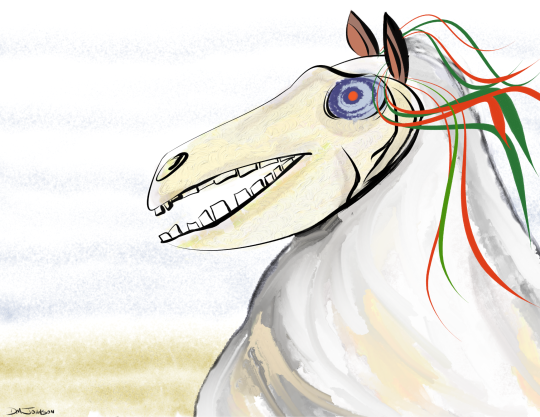
6 notes
·
View notes
Text
According to Wikipedia there is some argument about what the name Mari Lwyd (or Y Fari Lwyd) actually means. "Grey Mare" is probably the best guess.
But it looks like this

and "lwyd" is pronounced "loyd", so
Merry Lloyd is my appropriated English mangling of it.
Or Mary Lloyd, if we're sticking with the mare skull aspect.
There are two of them and they are married.
Married Lloyd.
(I'm like 1/64th Welsh, I can ruin this if I want.)
0 notes
Text
haven't seen the anyone upload the best video of the welsh holiday horse skull yet
#y fari lwyd#dwi'n caru'r ffidio yma cymaint#dwi 'di gweld fwy o byst amdano'r fari eleni#a mae'n neud fi'n hapys#tybed a fydde nhw'n neud y fari unrhywle blwyddyn yma.....#christmas#wales#cymru#cymraeg#welsh#skull#horse#mari lwyd
27K notes
·
View notes
Photo
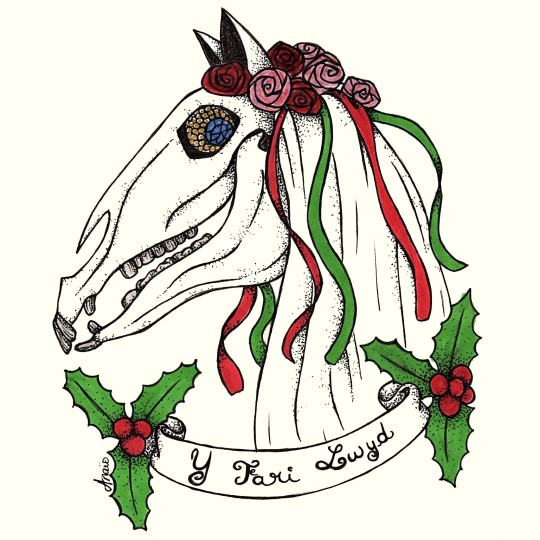
Mari Lwyd 🎄
[Fr/Eng]
La Mari Lwyd ou Y Fari Lwyd (qui se traduit par "jument grise") est une tradition galloise pratiquée durant la période de fin d'année, de Noël au Nouvel An. La coutume, censée porter chance, est d'accompagner la jument (un volontaire déguisé) d'un foyer à l'autre, pubs y compris, et de chanter pour les propriétaires qui les invitent ensuite à leur table.
The Mari Lwyd or Y Fari Lwyd ("gray mare") is a Welsh tradition practiced during the end of year period, from Christmas to New Year. The custom, supposed to bring luck, is to follow the mare (a disguised volunteer) from one home to another, including pubs, and singing to the owners to be invited to their table.
#me#christmas#christmas is coming#mari lwyd#y fari lwyd#welsh folklore#hobby horse#traditional art#traditional drawing#ink drawing#artists on tumblr
34 notes
·
View notes
Text
i’m not entirely sure why social media has gone absolutely wild for the mari lwyd but i’m here for it
35 notes
·
View notes
Text


"Wel dyma ni’n dwad,
gyfeillion diniwad,
I ofyn am gennad,
I ofyn am gennad,
I ofyn am gennad,
I ganu."
-
("Well, gentle friends
Here we come
To ask may we have leave
To ask may we have leave
To ask may we have leave
To sing." (Translation: National Museum of Wales))
-
("Can Y Fari Lwyd" - Traditional)
-
Mari Lwyd (Grey Mare? Holy Mary?) is the name most generally applied in Wales to the horse–figure carried from door to door by wassail–singing groups during the time between Christmas and the end of January. This tradition seems to have been once known all over southern Wales and probably even parts of England, although it declined in the early to mid-twentieth century. The singers would request entry to the local houses through the medium of song. The householders would then be expected to deny them entry, again through song, and the two sides would continue their responses to one another in this manner. If the householders eventually relented, then the team would be permitted entry to the house, where they would be given food and drink and would cause all types of mayhem. Letting them in was said to be good luck for the new year.
-
This is why this is my first post of 2021! I love reading up on folk customs like this one, so I had a stupid amount of fun doing the research for the painting. :D And there's just something super cool about rap-battling a horse skull to protect your pantry! I wish we still had traditions like this where I live.
#my art#mari lwyd#wales#welsh tradition#welsh folklore#folklore#yule#yule art#folklore art#watercolor painting#watercolourpainting#watercolour#watercolour art
107 notes
·
View notes
Text
Mari Lliwgar! (Mari Lwyd but colourful - and gay!)
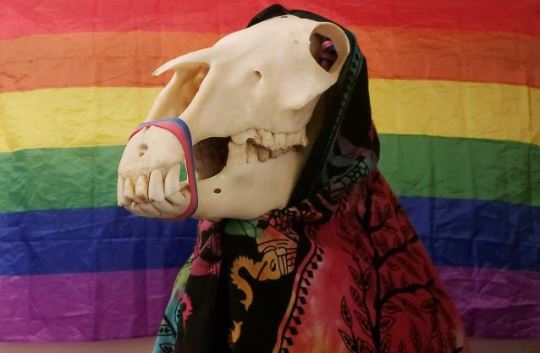

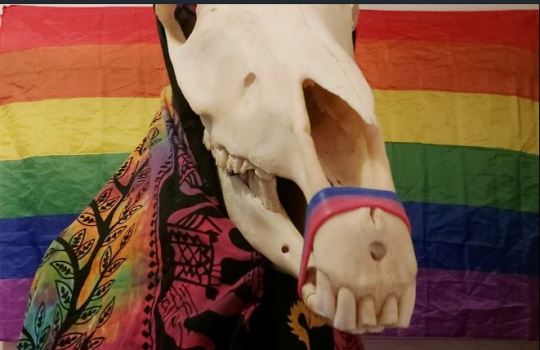
Some more stills from my video of the Mari Lliwgar in all their glory! Technically this is a male horse's skull (so more of a March than a Mari) but I had a lot of fun putting them together!
Once I have more materials I'll make their getup a little more elaborate than it is now. Hope you enjoy and Nadolig Llawen
Thank you all for another year of Llyfr Enfys (a project to create an LGBT+ Welsh Dictionary). See you in 2024!
147 notes
·
View notes
Photo

Traditionally a New Year’s Eve celebration, there has been a growing interest in Y Fari Lwyd in recent years which has seen a resurgence in groups performing this tradition across Wales. Y Fari Lwyd (translated as the Grey Mare, or The Grey Mary) and her group go from house to house and pub to pub and try to gain access by performing a series of verses, or ‘pwnco’. The inhabitants would reply with their own verses in a battle to outwit Mari and her gang and prevent her from entering. Eventually she will be let in, as this confers luck on the household for the coming year and scares out anything unwanted from the previous year. Once inside, more songs are sung and the group is given drinks and food. Mari often becomes quite mischievous and takes particular fancy to any young women there, chasing them and generally causing trouble.
The tradition of Y Fari Lwyd has certain pre-Christian origins. In Celtic Britain, the horse was seen as a symbol of power and fertility and prowess on the battlefield. In Celtic mythology, animals who had the ability to cross between this world and the underworld (the Celtic Annwn) are traditionally white or grey coloured. Arawn, King of Annwn’s dogs, are white with red ears and he rides on a large grey horse:
96 notes
·
View notes
Text
Hey folks, it’s strange Welsh customs time!
'Y Fari Lwyd' or ‘Mari Lwyd [MArry LOID]’ (The Grey Mare) is a ancient Welsh custom, typically celebrated on New Year's Eve, it involves the 'Mare' and her group going from door to door (and pub to pub!) trying to gain access by signing verses, or 'Pwnco'. The group accompanying the mare dress up (originally in rags but then evolved to Sunday Best with time) with darkened faces this was not blackface, this is ceremonial as to make the person ‘anonymous’ and distance themselves from their everyday life.

The inhabitants would sing counter verses to not let the Mare in, this would proceed until they ran out of excuses, when the Mare eventually enters, more songs are sung and the group is given food and drink.
This would bestow your household with luck for the coming year and drives out the bad luck from the previous year, the Mare is supposed to mischievous in nature.
Typically a horse skull was affixed to a pole with a white sheet attached to cover the leader, it is then decorated with ribbons and flowers. In some instances the jaw could move with a pulley device.

From what I understand of it, this was a pre-christian celebration and is unique to South Wales (particularly Glamorganshire), originating from the celebration of a new year and life coming back to the world as the turn of Spring begins (hence a dead horse coming back to life), a lovely little bit of obscure Welsh history! I unfortunately have never attended one, even though I live near Chepstow which does a regular Mari Lwyd every year, maybe I should change that soon.
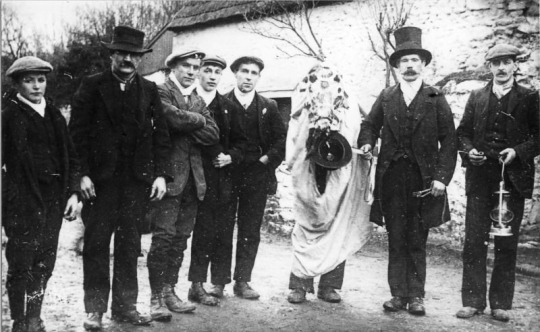
78 notes
·
View notes
Photo
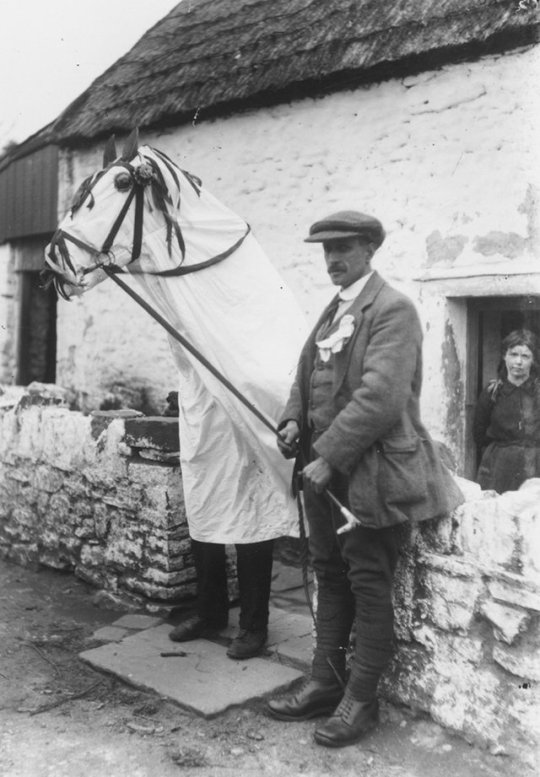
Pen neu ffigwr ceffyl wedi'i addurno oedd y Fari Lwyd. Yma yn Llangynwyd c. 1904-10. Arferai partïon canu gwaseila gludo'r Fari o ddrws i ddrws yn ystod tymor y Nadolig.
The 'Mari Lwyd' (Grey Mare) is the name given to the decorated horse-figure formerly carried from door to door by wassail-singing groups during the Christmas season in Wales. Here seen in Llangynwyd, c.1904-10.
Read more about the Mari Lwyd on our blog.
#museum#history#wales#welsh#cymraeg#christmas#customs#traditions#cultural history#national museum wales
227 notes
·
View notes